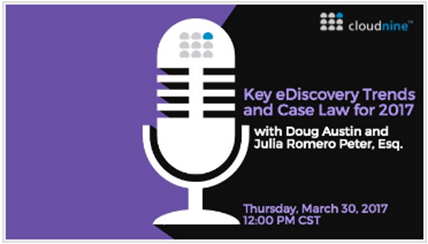Defendant Ordered to Reproduce ESI in Native Format, As Originally Requested by Plaintiffs: eDiscovery Case Law
In Morgan Hill Concerned Parents Assoc. v. California Dept. of Education, No. 2:11-cv-3471 KJM AC (E.D. Cal. Feb. 2, 2017), California Magistrate Judge Allison Claire granted the plaintiffs’ motion to compel the defendant to produce emails in native format with all metadata attached, but denied the plaintiffs’ motion for sanctions without prejudice to its renewal using Sacramento rates for attorneys’ fees. Judge Claire also denied the defendant’s motion for a protective order regarding production of the native format data, and its motion for sanctions.
Case Background
In this case regarding alleged violations of the Individuals with Disabilities Education Improvement Act, the plaintiffs served their First Set of Requests for Production of Documents in April 2013. The request specified that the ESI should be produced “in their native electronic format together with all metadata and other information associated with each document in its native electronic format.” One month later, the defendant responded, but did not object to the instruction that ESI be produced in native format and did not propose any other format for producing the ESI, instead objecting to nearly every individual request in the First Set on the grounds that they were “unduly burdensome”, “not relevant to the present litigation,” and protected by the attorney client and deliberative process privileges.
In October 2013, the defendant submitted a proposed protective order to the court where it “observe[d]” that “the question whether to produce metadata generally involves a balancing test ….”. The defendant subsequently claimed this was its original objection to the production of ESI in native format – they didn’t explicitly object to native format production until a letter sent to the plaintiffs in August 2016. According to the defendant, they had produced ESI “as load files, a standard format approved by the Special Master on April 7, 2016.” The parties met and conferred on the format of production issue in October 2016 without success.
Judge’s Ruling
With regard to the defendant’s argument that “[a] requesting party cannot demand production in one format versus another just because one would allegedly ease a party’s review process,” Judge Claire stated: “This argument runs directly contrary to the governing Rules, which expressly state just the opposite: the requester ‘may specify the form or forms in which electronically stored information is to be produced.’… Indeed, CDE’s dismissive rejection of ‘ease’ of review as a valid reason for specifying the format is difficult to understand, since ease of review is precisely why the requesting party would specify the format, and it is the very reason the requester is permitted to do so.”
With regard to the defendant’s argument that it can ignore the plaintiffs’ request for native format and produce it in some other format so long as the production is in a “`usable form, e.g., electronically searchable and paired with essential metadata’”, Judge Claire noted that the “The Rules specify that the responding party may produce ESI ‘in a reasonably usable form’ if the request ‘does not specify a form for production.’” Since the plaintiffs’ request did specify it, Judge Claire ruled that “there was no basis for CDE to simply ignore it and produce it in a format of CDE’s own choosing.” Judge Claire also rejected the defendant’s “attempt to drag the Special Master into this dispute” via undocumented recollection of an ex parte phone call approval from the Special Master, by noting that the Special Master is a technical consultant only, “not a judge who could ‘approve’ or disapprove of discovery production formats.”
Judge Claire also rejected even the defendant’s earliest claimed date of objection (October 2013) as untimely, since it was “six months after the document requests were served” and also ruled the more explicit objection in August 2016 as untimely as well.
As for the defendant’s argument that reproducing the ESI in native form would be burdensome, Judge Claire stated: “The court rejects this argument because this is a problem of CDE’s own making. CDE created the problem it now complains about by engaging in an ESI production in a format of its choosing — the ‘load file format’ — rather than the native format, with all metadata attached, as plaintiffs had requested.” Judge Claire also noted that the defendant could have produced it originally in the requested format or objected in a timely manner and worked to meet and confer with the plaintiff – neither of which happened.
As a result, Judge Claire granted the plaintiffs’ motion to compel the defendant to produce emails in native format with all metadata attached. Judge Claire denied the plaintiffs’ motion for sanctions without prejudice to its renewal using Sacramento rates for attorneys’ fees and also denied the defendant’s motion for a protective order regarding production of the native format data, and its motion for sanctions.
So, what do you think? Could the defendant have gotten its way if it had objected in a timely manner? Please share any comments you might have or if you’d like to know more about a particular topic.
Disclaimer: The views represented herein are exclusively the views of the author, and do not necessarily represent the views held by CloudNine. eDiscovery Daily is made available by CloudNine solely for educational purposes to provide general information about general eDiscovery principles and not to provide specific legal advice applicable to any particular circumstance. eDiscovery Daily should not be used as a substitute for competent legal advice from a lawyer you have retained and who has agreed to represent you.







